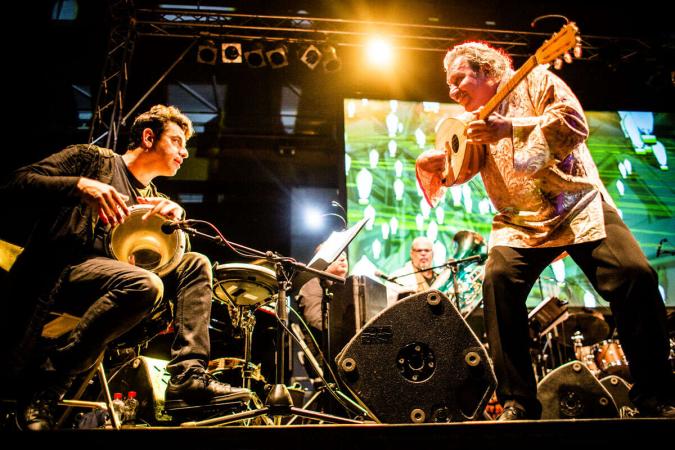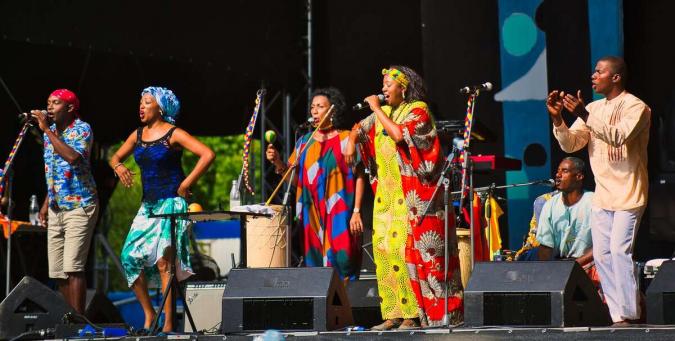Today we live in an age of global migration in which cultural variety and multinational societies have become the norm. In this context, world music is often welcomed as the harbinger of equal coexistence among the cultures. Few other segments of the music market can match its claim to and aura of egalitarianism. [1] At times, conversely, world music is viewed with a critical eye – as the ‘prolonga tion of colonialism’, for example, ‘in which an omnipotent West exploits the sub altern remainder of the world in order to satisfy its craving for exotic entertainment while replicating dubious clichés of authenticity’. [2] The field of tension between these two positions forms the framework for the debates as to what should be regarded as world music, from what point the term has been applied, and how it should be defined in German-speaking countries.
What is world music?
Terms such as ‘world music’, Weltmusik and musique du monde have been used in various contexts since the early 20th century, ultimately finding their way into various types of music. Finally, in 1987, world music became a marketing tag in the recording industry for popular music from countries outside the ‘Anglosphere’, with no fewer than 11 independent European and American record companies specialising in popular music from developing countries introducing the term. [3] Since then it has frequently been used not so much to designate a musical genre, but as a commercial label for artists such as King Sunny Adé, Youssou N’ Dour, Warda, Nusrat Fateh Ali Khan or Cesaria Evora. It thereby serves as a label for pop musicians from developing countries who have achieved success in the international marketplace. In this light, ‘world music’ is a marketing tool used to denote products of an artistic exchange between the global north and south. [4] When employed in this context, the term often takes on neg ative connotations, as a nostalgic picture of authenticity and a longing for musical primitivism, [5] or an exemplar of the West ern appropriation of traditional non-Western forms of music. [6] At times world music is even viewed as a commercial fraud, as new musical raw material extracted from exotic nations to enrich the spectrum of the international music landscape. [7] These negative implications of the term are directly related to such developments as glob alisation, colonialism and cultural imperialism.
Nonetheless, attempts have also been made to define world music as a genre and a musical category. Some characterise it as a popular music that originated in the 1980s. According to this view, world music is internationally commercialised music from developing countries, combining local features with elements of today’s transnational music industry. [8] According to another definition, world music is a special form of music-making and a style with its own characteristic properties, which however are not always described in detail. Finally, it is also possible to view world music as a synthesis of tensions between modernism (as related to technology, the commodity market and such all-embracing global genres as rock and pop) and tradition (as related to the use of so-called traditional instruments or genres). [9] Consequently, world music is frequently considered to be modernized ‘traditional’ music or modern music with a ‘traditional tinge’. This raises the problem that this alleged ‘genre’ encompasses a great many musical genres at once: zouk from Guadeloupe no less than Jamaican reggae, Colombian cumbia no less than morna from Cape Verde.
Often, world music is linked with an aura of resistance. In this way it be comes a societal field associated with concepts such as diaspora, multiculturalism, postcolonialism, cultural integration and cultural relativism. [10] Not least of all, world music can be understood quite generally as a term for the music of the world. From this vantage point, it embraces all globally existing musical practices rather than referring to a specific repertoire. [11]
Given these highly contrasting positions, it is clear that the debates on world music harbour a number of dichotomies: global vs. local, modern vs. traditional, profitoriented vs. functional, hybrid vs. authentic. Although the term is associated with such phenomena and developments as globalisation, migration, cultural identity, resistance and authenticity, the nature of the relation is often left unspecified. Indeed, often enough it can even be contradictory: depending on the debate, world music can be interpreted as an expression, a forerunner or a consequence of globalisation, and sometimes as the appropriation of Western elements or a product of cultural imperialism.
World music in the German-speaking countries
In Germany, the term ‘world music’ has taken on a quite particular slant. The Global Music Academy in Berlin, for example, views world music primarily as music that unites elements from internationally significant musical cultures. [12] By this it means a sort of musical Esperanto that can embrace all musical cultures, even though sharply defined international differences are plain to hear. [13] In this context, world music is seen as part of a cultural-political process intended to promote cultural variety in Germany by lending visibility to the music of minorities. [14]
In more recent publications, world music in Germany is also referred to as a ‘scene’, [15] that is, a network of people who interact either virtually or physically and share their musical taste. This scene consists not only of musicians, but equally of concert organisers and consumers, and is closely linked to the country’s demographic development. According to figures from the Federal Statistical Office, in 2017 more than 23 per cent of the German population had an immigrant background. People from many nations have settled mainly in the cities, including some 1.5 million Turks, roughly 900,000 Poles and several hundred thousand Asians, Africans and Latin Americans. [16] It is thus unsurprising that world music in Germany is a primarily urban phenomenon centred in cities such as Berlin, Cologne, Hanover, Hamburg and Munich. As the population of these cities is now multi-cultural, a new musical landscape has emerged.
The two terms employed in Germany for this phenomenon – Weltmusik and Globale Musik – are ambiguous and have to date eluded clear definition. The understanding of ‘world music’, for example, even overlaps with the medieval concept of musica mundana or with Karlheinz Stockhausen’s notion of supra-national music. [17]
Yet, to interpret the term as music that unites elements from internationally significant musical cultures is to exclude Stockhausen’s work as well as other musics based on fusion (Aggro-Berlin Rap, German rock music), even though they too have transcultural elements. The more recent term ‘global music’, in contrast, attempts to escape the colonial implications in the concept of world music. If the keyword ‘global’ is meant to indicate the presence of formerly ‘local’ cultures in a global context, this interpretation leads to misleading points of view: the guitar, probably the most widespread instrument in the world, would not count as a global instrument, whereas a primarily local instrument such as a Turkish zurna would be proclaimed global because it is played in Berlin or Paris, even though it remains unknown in New York, London and Tokyo. Nor can ideas as to what constitutes ‘local’ or ‘global’ be separated from geopolitical implications.
Finally, discussions of world music in Germany sometimes tend to hinge on the question of subsidy, as happens, say, in the injunction to ‘promote artists from developing countries’. [18] However estimable this commitment might seem, it implicitly assumes that the persons involved would not be able to establish them selves without state or private support. Nonetheless, world music plays an important part in the debates on integration of minorities or refugees in Germany, as it helps to direct attention to their positive cultural impact. World music in Germany is thus an open field whose boundaries are vague and indistinct both in terminology and in musical manifestations.
From an institutional standpoint, Germany’s world music scene is far less tightknit and interconnected than, say, the jazz, contemporary music or popular music scenes. The reasons for this doubtless lie in its relatively recent history, its beginnings as a commercial category rather than one with clear-cut stylistic forms, and societal developments that have only recently given rise to a novel multiplicity of styles in the wake of globalisation. As a result, today Germany offers few specia lised training courses or well-established grant programmes in world music, unlike in contemporary music or jazz. Consequently the music itself has sought the many and varied niches in which its practitioners respond to the conditions pertaining in their particular locale.
The scene: prizes, festivals and labels
Scenes, as societal spaces for post-traditional communitisation are fundamentally unstable. [19] The world music scene, too, does not presuppose a well-defined identity for its members. Even so, a few criteria can be descried. Although foreign musicians living in Germany, or those with an immigrant background, are an important part of the scene, so are white German musicians who take an interest in the music of other cultures. Active artists can avail themselves of both a popular and a highbrow format as long as they agree to musical fusions and have an openminded attitude. Another important part of the scene, in addition to practicing musicians, are producers and concert organisers, many of whom are white German. Sim ilarly, the main audience for world music is by no means made up entirely of migrants, but rather of people seeking activities for intercultural encounters. [20] That said, it is frequently lamented that the audience for world music is growing old, like that of classical music, and at times the scene has a difficult time appealing to younger audiences.
For all participants, ‘the world music scene also operates quite obviously outside the bounds of egalitarian principles. It has created formats that not only tolerate hierarchies and rivalries but elevate them to a constitutive principle: trade fairs, competitions and awards. In all these formats, musicians compete with each other, whether for money, prestige, or often both’. [21] On the other hand, competitions and prizes also create necessary spaces for the dissem ination of world music in Germany. Here special mention should be made of the ‘creole global’ Music Contest in Berlin, as well as the Folk & World Music (Baden-Württemberg) and Global Music (North Rhine-Westphalia) competitions, funded by the music councils of those states. Equally deserving of mention is the German Record Critics’ Prize and RUTH, the German World Music Prize, both of which focus on German productions. The transVOCALE Prize of the European Festival of Song and World Music in Frankfurt an der Oder honours musicians from Germany and Poland.
Festivals in turn function as a link between the national and international scenes, in that they showcase not only international artists but also groups from Germany. The major festivals along these lines are the Africa Festival in Würzburg, the ‘MASALA Welt-Beat’ Festival in Hanover, the Morgenland Festival in Osnabrück and the Roots Folk Weltmusik Festival in Rudolstadt. Several festivals have annual themes and focus on such aspects as regions, countries, musical genres or instrument families. [22] Festivals with an emphasis on world music are found in almost every state in Germany, particularly Bavaria, Berlin, Lower Saxony, North Rhine-Westphalia and Thuringia.
.Turning to recordings, labels such as Piranha Records, Outhere Music, Eastblok Music and Asphalt Tango are particularly active in releasing music by both international and German artists. World music can also be heard throughout the country on public radio, and especially on online and web radio platforms, which currently offer 72 broadcasters (see Holger Schramm’s essay ‘Music in Broadcasting’).
Finally, other institutions committed to the communication and dissemination of world music topics are PROFOLK, a registered association for song, folk music and world music in Germany (founded in 1995 as the successor to the Profolk Umbrella Group for Folk Music) and the bimonthly periodical Folker, at present Germany’s only journal for folk, song and world music. The online portal Globalflux provides infrastructural data and current schedules specifically for the state of North RhineWestphalia. Initiated for practicing musicians, this platform offers insights into the state’s world music scene to all interested parties. It also provides information on current congresses, such as the Second General Debate on the Future of Musical Diversity in North Rhine-Westphalia. [23]
Research and education
For a long time academic circles displayed minimal interest in the phenomenon of world music. Even ethnomusicologists who viewed their subject expressly as dealing with non-European music gave world music a wide berth. Legal disputes between artists from the West and others from Africa, Latin America and Asia, or between Western artists and ethnomusicologists such as Simha Arom and Hugo Zemp, ensured that world music was not always seen in a positive light in the musicological literature. Even scholars in the German-speaking countries initially adopted a critical stance.
In more recent years the views have become increasingly more appreciative. Ethnomusicologists now take part without further ado in juries at competitions such as ‘creole global’, become involved as consultants in the organising of festivals and lend their support to initiatives, congresses, concerts and teaching institutions. In 2018 the German Musicological Society (Gesellschaft für Musikforschung) devoted part of its annual convention to ‘Music of the World and its Music-Educational Contexts’.
Similarly, the training of specialised musicians in Germany has improved. Be sides the Global Music Academy in Berlin (founded in 2009), there are now relevant cours es of study at the Baden-Württemberg Pop Academy in Mannheim and at Rostock University of Music and Theatre. Preparatory courses for tertiary-level studies and educational offerings for young people and adults form part of the curriculum at the Oriental Academy of Music in Mannheim, founded in 2008 with the goal of enabling musical and intercultural encounters. The ETHNO Project, sponsored by Jeunesses Musicales, offers workshops, jam sessions, seminars and performances specifically to give young musicians an opportunity for intercultural exchange. The Conservatory of Turkish Music in Berlin (a private institu tion) offers courses in the folk music and court music traditions of Turkey. The Center for World Music, run by the Hildesheim University Foundation, devotes itself not only to its own research and its unique nationwide advanced training pro gramme for professionals (‘musik.welt: cultural diversity in musical education’), but also the scholarly archiving of world music. Further, the State Music Academy of North RhineWestphalia offers degree courses for music teachers from various cultures. Working jointly with the Oriental Academy of Music in Mannheim, the Baden-Württemberg Pop Academy and the Association of German Music Schools, the National Academy for the Education of Young Musicians (Bundesakademie für musikalische Jugendbildung) in Trossingen will offer, beginning in 2019, an 18-month course in ‘welt. kultur-praxis’ aimed at trained musicians from all cultures.
The establishment of world music in musical scholarship and its entrance into educational institutions are indications that world music, as an expression of cultural diversity, has found increasing acceptance in Germany, both in the public eye and in state institutions of learning. As crossover music, it has in many cases parted company with its cultural origins and entered new stylistic connections with other genres, thereby ensuring a steady stream of new impulses into the musical life of Germany and the world at large.
Footnotes
Kerstin Klenke, ‘Messen, Wettbewerbe, Auszeichnungen’, in Claus Leggewie and Erik Meyer, eds., Global Pop: Das Buch zur Weltmusik (Bonn, 2017), pp. 171-79, esp. p. 171
Kerstin Klenke, ‘Weltmusik in Deutschland’ (unpubd. MS., 2017), 2 pp., quote on p. 1.
Tony Mitchell, ‘World Music and the Popular Music Industry: An Australian View’, Ethnomusicology 37 (1993), pp. 309-38, esp. p. 310.
Deborah Pacini Hernandez, ‘Dancing with the Enemy: Cuban Popular Music, Race, Authenticity, and the World-Music Landscape’, Latin American Perspectives 3 (1998), pp. 110-25, esp. p. 111.
Veit Erlmann, ‘The Politics and Aesthetics of Transnational Musics’, The World of Music 35/2 (1993), pp. 3-15, esp. pp. 8-13.
Andrew Goodwin and Joe Gore, ‘World Beat and the Cultural Imperialism Debate’, Socialist Review 20 (1990), pp. 63-80, esp. p. 63.
Jocelyne Guilbault, ‘Interpreting World Music: A Challenge in Theory and Practice’, Popular Music 16 (1997), pp. 31-44, esp. p. 32.
Jocelyne Guilbault, ‘On Redefining the “Local” Through World Music’, The World of Music 35/2 (1993), pp. 33-47, esp. p. 36.
Erlmann, ‘Transnational Musics’ (see note 5), p. 7.
Daniel Siebert, Musik im Zeitalter der Globalisierung: Prozesse, Perspektiven, Stile (Bielefeld, 2015), pp. 144 f.
Philip V. Bohlman, World Music: A Very Short Introduction (Oxford, 2002), p. xi.
See https://global-music-academy.net/global-music-school (accessed on 7 December 2018).
Deborah Pacini Hernandez, ‘A View from the South: Spanish Caribbean Perspectives on World Beat’, The World of Music 35/2 (1993), pp. 48-69, esp. pp. 55-58.
Birgit Ellinghaus, ‘Zwischen Kulturpolitik und Kreativwirtschaft: Weltmusik in Deutschland’, in Claus Leggewie and Erik Meyer , eds.: Global Pop (Bonn, 2017), pp. 180-87, esp. p. 185.
Daniel Bax, ‘Weltmusik als Markt und Marke’, in ibid., pp. 155-64, esp. p. 159; Ellinghaus, ibid., p. 182.
Statistisches Bundesamt, ed., Bevölkerung und Erwerbstätigkeit: Bevölkerung mit Migrationshintergrund, special series 1, series 2.2, and Ausländische Bevölkerung, special series 1, series 2 (Wiesbaden, 2018).
Siebert, ‘Globalisierung’ (see note 10), p. 87.
Ellinghaus, ‘Zwischen Kulturpolitik und Kreativwirtschaft’ (see note 14), p. 186.
Ronald Hitzler and Arne Niederbacher, Leben in Szenen: Formen juveniler Vergemeinschaftung heute (3rd edn., Wiesbaden, 2010), p. 18.
Frank Lücke, Weltmusik in Deutschland: Multikulturelle Musik in den Medien (Hamburg, 2011), p. 89.
Klenke, ‘Messen, Wettbewerbe, Auszeichnungen’ (see note 1), p. 171.
Lücke, Weltmusik in Deutschland (see note 20), p. 80.
http://www.globalflux.deSee http://www.globalflux.de (accessed on 7 December 2018).







